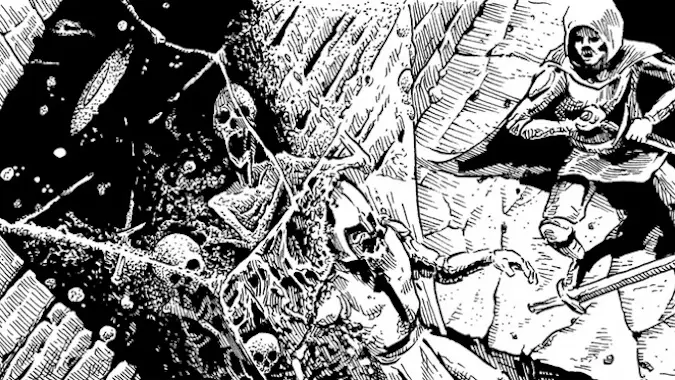Explore dungeons without the drudgery with the award-winning Shadowdark TTRPG

At GenCon 2024, three of tabletop gaming’s most prestigious awards — the ENNIES — were swept not by a certain toy conglomerate who wants $180 for a half-edition revision bump, but by a tabletop game that escaped many gamers’ notice until its win: Shadowdark. Taking home the awards for Best Rules, Best Layout & Design, and Product of the Year, this game might be perfect if you’ve ever found yourself twiddling your thumbs waiting your turn in D&D combat, or if you’ve been curious about so-called “Old School Renaissance” games but found the idea of learning an entirely new rule system daunting. Shadowdark manages to combine the familiar modern and the evocative old-school flavors of RPG into something new and exciting — a game I can honestly say might be my new ideal fantasy tabletop game.

What is Shadowdark?
Written by designer Kelsey Dionne (who also wrote the highest-rated adventure ever on the DMs Guild website, Secrets of Skyhorn Lighthouse), Shadowdark aims to evoke the gameplay and general feeling of “Old School Renaissance” (or OSR) games without necessarily forcing people to learn a tabletop game that is entirely alien to them — a lot of modern game design sensibilities are smart for a reason, and Shadowdark uses a lot of them where it makes sense.
At its core, Shadowdark is something familiar — it’s a game where you make adventurers who delve into dungeons after gold and glory, explore uncharted wildernesses and the cool stuff therein, and fight terrible villains and their machinations in their lairs. However, it’s also fast, fluid, and returns tabletop play to what it’s always been possible to be — a conversation and a story where dice get rolled when the stakes are high — while ensuring that it’s as approachable as it could possibly be, to welcome in new players instead of alienating or confusing them from the get-go.

What does Shadowdark do differently?
A lot of OSR games attempt to evoke the “rulings over rules” era of older editions of D&D by reproducing what amount to cleaned-up editions of older games — for example, one of the most widely acclaimed games, Old School Essentials, is almost exactly a replica of the first edition of D&D (and even offers an add-on book to replicate the feelings of Advanced Dungeons & Dragons 1st Edition). These kinds of games do succeed at evoking a specific feel, but at the cost of introducing rules that can be a real speedbump to getting modern players interested in them: try explaining THAC0 to gamers who’ve been playing with ascending armor class for nearly a quarter of a century, or the extremely weird ordering involved in combat in older editions of D&D where your order varies depending on what your action is, not something more familiar like initiative. (It’s telling that Old School Essentials introduces THAC0 then also immediately has rules for using ascending armor classes literally on the same page, and uses both numbers through all of its rules.)
Dionne recognizes that you can evoke a feeling in a game without throwing the baby out with the bathwater, and so players will find a lot here that’s still familiar. Rolling up your stats? The method is decidedly old school (roll 3d6 six times, assign to stats), but the results are not — you end up with scores 3-18, you know what the stats are, and the modifiers are exactly what you think they are. Find yourself in an advantageous situation? You’re going to roll two 20-sided dice and keep the best. In fact, you’re rolling a d20, adding modifiers, and trying to roll high to do things. These are things that work, and the game recognizes it and doesn’t get rid of them just to differentiate itself. It also doesn’t slavishly reproduce some things that are present in OSR games but frankly just aren’t fun: the wizard that has one spell for the entire day then has to fall back on a dagger? Not fun, for anybody, but it keeps showing up, because “that’s how it used to be” — not in Shadowdark.
At the same time, you get aspects of the game that specifically aim to make dungeon-crawling feel dangerous again. Torches are wildly important — none of the ancestries here can see in the dark, but all of the monsters can, so light management becomes important again and full darkness is deadly. Wizards and clerics can keep casting spells as much as they want per day, but they do so with skill rolls — and messing up can have backfires, because arcane magic is weird and dangerous, and the gods are fickle. Hit points are low (for everyone involved) and you’re not laden with forty different options on your character sheet, so combat is fast at all levels but also deadly. Monsters have morale, and are more likely to act intelligently and flee when in danger, making them more than just punching bags full of experience points. Ranges are simplified into close, near, and far, but those also apply to ranges, for those of you who like your grid maps and minis. No defined list of skills means you’re free to try and do things whether you’re proficient or not, while class talents can grant advantage in those specific moments.
It also has swift, punchy writing that puts a priority on being clear and usable in the moment, not requiring you to flip between pages hoping that you’ve grasped every fine point of a rule. Each character class (not counting spell lists) fits on a two-page spread. Spells are at most a couple of paragraphs, and written in a way that they’re easy to grasp intuitively — you aren’t going to need to constantly refer to a website to get the exact wording of the newest edition and errata of a spell or ability. Shadowdark is extremely easy to use in the moment in a way that even other OSR games could stand to learn something from.

Fine, you’ve convinced me. Where can I get Shadowdark?
Shadowdark is available at The Arcane Library, in both print and PDF versions — the print version is actually just back in stock after a successful first run on Kickstarter — at $59 for both print and PDF, or just $29 for the PDF. As a bonus, if you’re a fan of solo tabletop RPGs, Shadowdark includes a full set of rules for solo play, entirely for free.
I also highly recommend picking up one or more of Shadowdark‘s associated zine, Cursed Scroll — each is available in print and/or PDF, and each is tightly themed and includes new classes, a hex map of a setting to explore, new rules, and a dungeon that’s ready to go straightaway for your players. (I’m especially fond of Vol. 3, Midnight Sun, featuring a Norse theme with sea wolves and seers in dragon-prowed longboats.)
Please consider supporting our Patreon!
Join the Discussion
Blizzard Watch is a safe space for all readers. By leaving comments on this site you agree to follow our commenting and community guidelines.
 @awaymessageclub
@awaymessageclub



